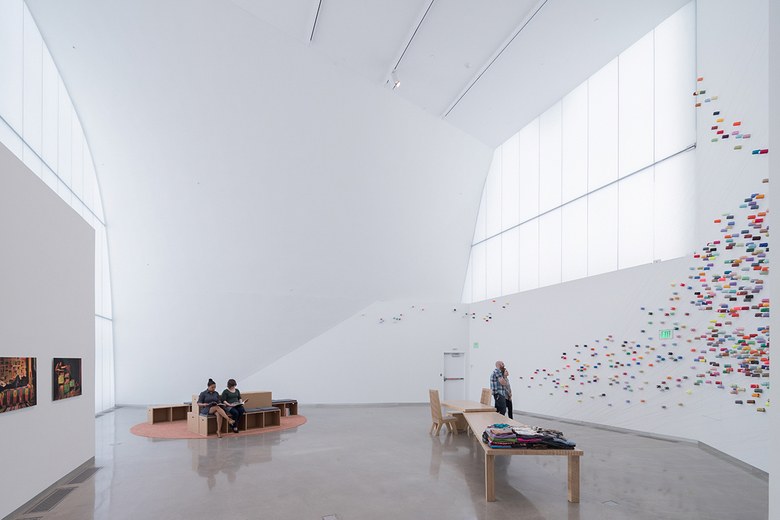Institute for Contemporary Art, VCU
Richmond, USA
Sited at the edge of the Virginia Commonwealth University campus in Richmond, Virginia, the new Institute for Contemporary Art links the University with the surrounding community. On the busiest intersection of Richmond at Broad and Belvidere Streets, the building forms a gateway to the University with an inviting sense of openness. The main entrance is formed by an intersection of the performance space and Forum, adding a vertical “Z” component to the “X-Y” movement of the intersection. The torsion of these intersecting bodies is joined by a “plane of the present” to the galleries in “forking time.”
The idea of “forking time” suggests that in the world of contemporary art there are many parallel times. The notion of one ongoing time and its “grand narrative” of history is questioned. The new Institute for Contemporary Art is organized in four galleries, each with a different character. Flexibility allows for four separate exhibitions, one continuous exhibition, or combinations. Galleries can be closed for installations without affecting the circulation to the others. One can begin the sequence through the four galleries by taking the oversized elevator to the top and circling down, or by beginning at the lower gallery of the Forum and moving up. Exposed concrete beams and planks in the galleries complement the concrete floors. As flexible spaces, the galleries can accept suspended art or projects anchored to the floor slab.
Vertical movement along the “plane of the present” links the galleries, the performance space, the sculpture garden and Forum. Along this architectural promenade, the integration of all the building elements can be experienced in changing views.
The 41,000-square-foot building has a double front: one side opens from the city, the other from the sculpture garden to the Forum, linking city and campus. On the ground level, the café opens directly onto the sculpture garden, as does the ground-level gallery. Pivot doors allow opening events to spill out into the garden. Paved in bluestone slabs and gravel, the garden is planted with gingko trees. A large reflecting pond of recycled water shapes the sense of this garden as a “Thinking Field.”
The building is an experience of movement in time around the exterior as well as the interior. Approaching on foot from the west (from the University), the building unfolds in the parallax of changing perspectives. As you walk, the crunch of gravel under your feet is complemented by a view that gradually opens to reveal the Forum. If you arrive by car from the north, east, or south, the double-vertical geometry in torsion marks a gateway presence, which changes shape as the car passes by. At night, glowing planes of obscure glass activate the exterior. Video projections may appear on these obscure glass walls, animating the outdoor space with art.
The 240-seat flexible performance space is fully equipped for film, theater, dance, and music performances. It connects the first floor with the second, where an overlook from the galleries provides an unexpected view between visual and performing arts.
The exterior matte translucent glass and pre-weathered titanium zinc skin share the same greenish-grey tonality, giving the building a shifting presence, from monolithic opaque to multifarious translucent, depending on the light. The four rooftop gardens include a sculpture terrace on the second level for site-specific artist installations. The LEED Gold building is heated and cooled with geothermal wells, harvesting the same amount of energy during the winter to heat the building as it restores in the summer to cool the building.
The Institute for Contemporary Art will be a new gateway and catalyst, linking the University and the city of Richmond. With its inviting double-fronted forum opening to a serene sculpture garden, it will provide spatial energy for the most important cutting-edge contemporary art exhibits. Propelled by VCU’s top-ranked School of the Arts, the ICA's architecture is an instrument for exhibitions, film screenings, public lectures, performances, symposia, and community events, engaging the University, the city, and beyond.
- Arquitectos
- Steven Holl Architects
- Localização
- 601 W. Broad Street, 23220 Richmond, USA
- Ano
- 2018
- Cliente
- Virginia Commonwealth University
- Equipa
- Steven Holl (design architect, principal), Chris McVoy (design architect, partner in charge), Dominik Sigg (project architect), Dimitra Tsachrelia (project architect), Garrick Ambrose, Rychiee Espinosa, Scott Fredricks, Gary He, Martin Kropac, JongSeo Lee, Yasmin Vobis, Christina Yessios
- Associate Architects
- BCWH Architects: Charles Piper (principal), Bo Fairlamb (associate), Jason Dufilho (project architect)
- Construction
- Gilbane, Inc.
- Structural Engineer
- Robert Silman Associates
- Civil Engineer
- Vanasse Hangen Brustlin
- Mechanical Engineer (Schematic Design)
- Arup
- Mechanical Engineer
- Ascent Engineering Group
- Landscape Architect
- Michael Boucher Landscape Architecture
- Lighting Consultant
- L’Observatoire International
- Audio/Visual Consultant
- Convergent Technologies Design Group, Inc.
- Theater Technical Consultant
- Theatre Consultants Collaborative
- LEED Consultant
- Sustainable Design Consulting






















